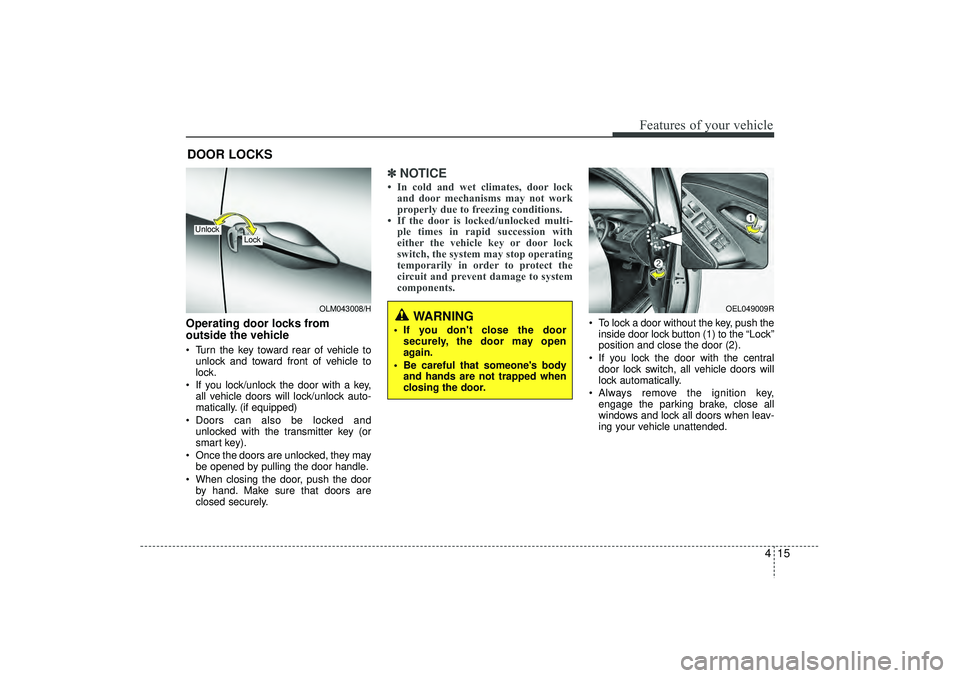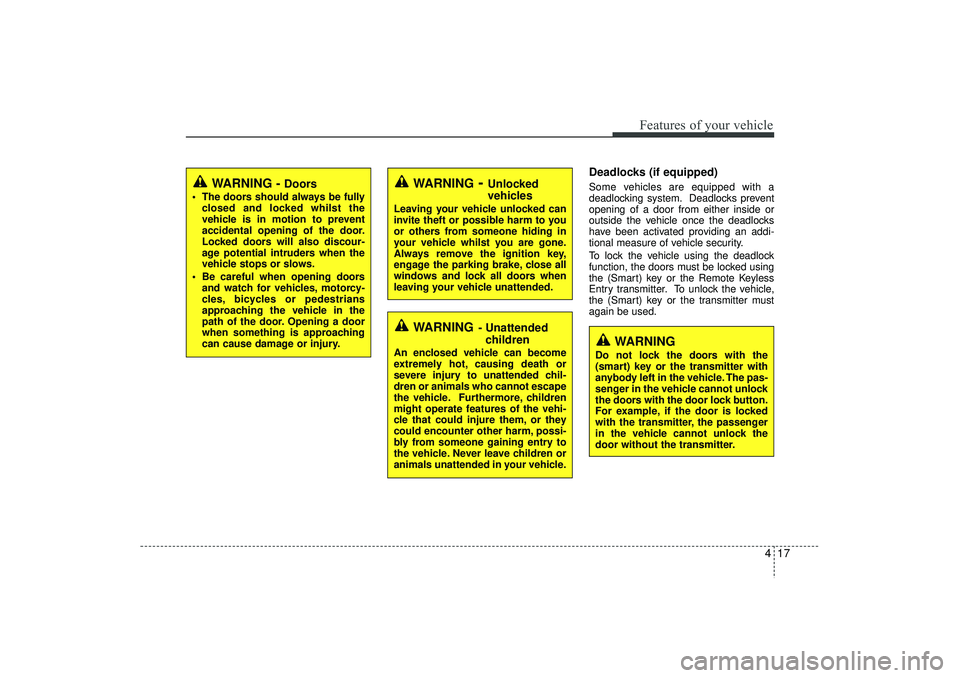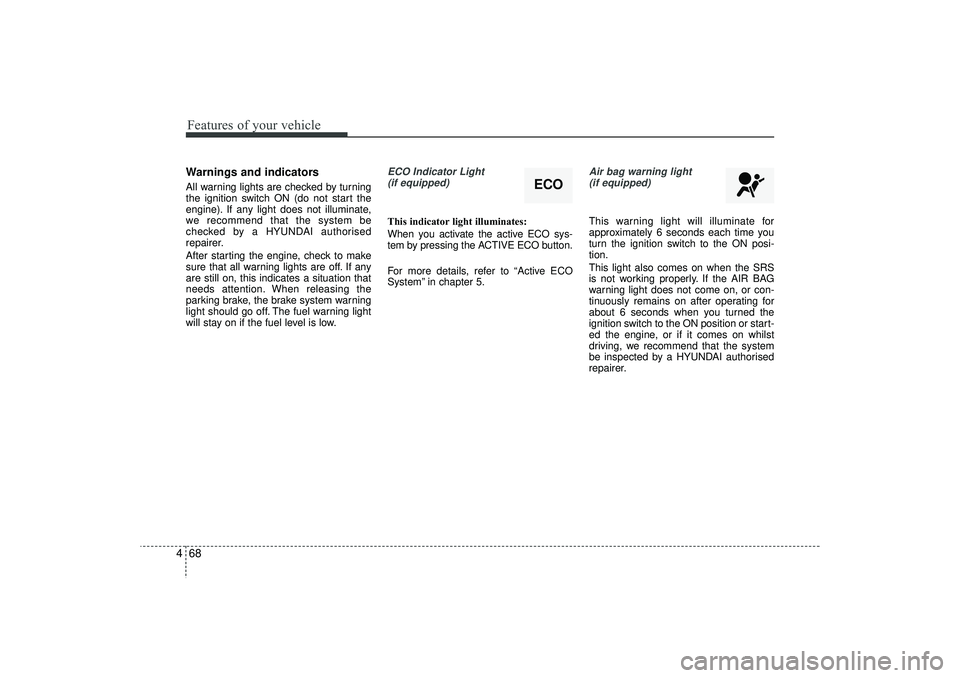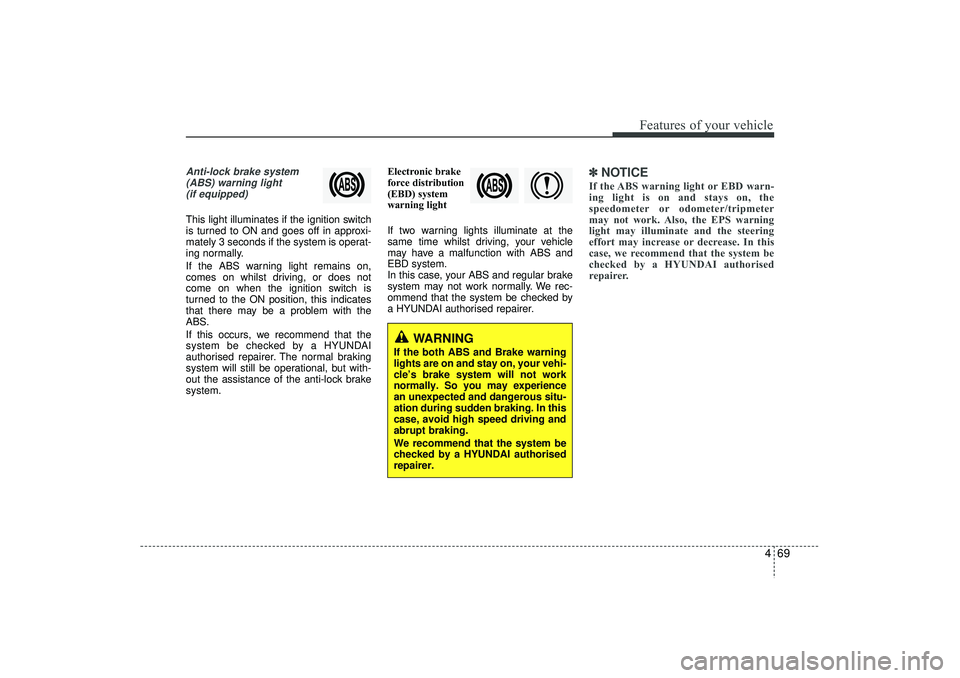Page 82 of 550

363
Safety features of your vehicle
Just before impact, drivers often brakeheavily. Such heavy braking lowers the
front portion of the vehicle causing it to
“ride” under a vehicle with a higher
ground clearance. Air bags may not
inflate in this "under-ride" situation
because deceleration forces that are
detected by sensors may be signifi-
cantly replaced by such “under-ride”
collisions.
✽ ✽ NOTICE - if equipped with
rollover sensorFront air bags do not inflate in rollover
accidents. However, side impact and
curtain air bags may inflate in a
rollover, when it is detected by the
rollover sensor. ✽ ✽NOTICE - without rollover
sensorAir bags do not inflate in rollover acci-
dents because vehicle can not detect
rollover accident. However, side impact
and/or curtain air bags may inflate
when the vehicle is rolled over after side
impact collision.
Air bags may not inflate if the vehicle
collides with objects such as utility
poles or trees, where the point of
impact is concentrated to one area and
the full force of the impact is not deliv-
ered to the sensors.
1VQA2090
1VQA2091
1VQA2092
EL(FL) UK 3.QXP 12/16/2014 8:57 PM Page 63
Page 100 of 550

415
Features of your vehicle
Operating door locks from
outside the vehicle Turn the key toward rear of vehicle tounlock and toward front of vehicle to
lock.
If you lock/unlock the door with a key, all vehicle doors will lock/unlock auto-
matically. (if equipped)
Doors can also be locked and unlocked with the transmitter key (or
smart key).
Once the doors are unlocked, they may be opened by pulling the door handle.
When closing the door, push the door by hand. Make sure that doors are
closed securely.
✽ ✽ NOTICE• In cold and wet climates, door lock
and door mechanisms may not work
properly due to freezing conditions.
• If the door is locked/unlocked multi- ple times in rapid succession with
either the vehicle key or door lock
switch, the system may stop operating
temporarily in order to protect the
circuit and prevent damage to system
components.
To lock a door without the key, push the
inside door lock button (1) to the “Lock”
position and close the door (2).
If you lock the door with the central door lock switch, all vehicle doors will
lock automatically.
Always remove the ignition key, engage the parking brake, close all
windows and lock all doors when leav-
ing your vehicle unattended.
DOOR LOCKS
OLM043008/H
Lock
Unlock
OEL049009R
WARNING
If you don't close the doorsecurely, the door may open
again.
Be careful that someone's body and hands are not trapped when
closing the door.
EL(FL) UK 4A.QXP 2/9/2015 9:03 PM Page 15
Page 102 of 550

417
Features of your vehicle
Deadlocks (if equipped)Some vehicles are equipped with a
deadlocking system. Deadlocks prevent
opening of a door from either inside or
outside the vehicle once the deadlocks
have been activated providing an addi-
tional measure of vehicle security.
To lock the vehicle using the deadlock
function, the doors must be locked using
the (Smart) key or the Remote Keyless
Entry transmitter. To unlock the vehicle,
the (Smart) key or the transmitter must
again be used.
WARNING -
Doors
The doors should always be fullyclosed and locked whilst the
vehicle is in motion to prevent
accidental opening of the door.
Locked doors will also discour-
age potential intruders when the
vehicle stops or slows.
Be careful when opening doors and watch for vehicles, motorcy-
cles, bicycles or pedestrians
approaching the vehicle in the
path of the door. Opening a door
when something is approaching
can cause damage or injury.
WARNING
Do not lock the doors with the
(smart) key or the transmitter with
anybody left in the vehicle. The pas-
senger in the vehicle cannot unlock
the doors with the door lock button.
For example, if the door is locked
with the transmitter, the passenger
in the vehicle cannot unlock the
door without the transmitter.
WARNING
- Unlocked
vehicles
Leaving your vehicle unlocked can
invite theft or possible harm to you
or others from someone hiding in
your vehicle whilst you are gone.
Always remove the ignition key,
engage the parking brake, close all
windows and lock all doors when
leaving your vehicle unattended.
WARNING
- Unattendedchildren
An enclosed vehicle can become
extremely hot, causing death or
severe injury to unattended chil-
dren or animals who cannot escape
the vehicle. Furthermore, children
might operate features of the vehi-
cle that could injure them, or they
could encounter other harm, possi-
bly from someone gaining entry to
the vehicle. Never leave children or
animals unattended in your vehicle.
EL(FL) UK 4A.QXP 2/9/2015 9:03 PM Page 17
Page 110 of 550
Opening the bonnet 1. Pull the release lever to unlatch thebonnet. The bonnet should pop open
slightly. 2. Go to the front of the vehicle, raise the
bonnet slightly, pull the secondary
latch (1) inside of the bonnet centre
and lift the bonnet (2). 3. Pull out the support rod.
4. Hold the bonnet opened with the sup-
port rod.BONNET
OLM049025R
OLM049027
WARNING
- Hot parts
Grasp the support rod in the area
wrapped in rubber. The plastic will
help prevent you from being burned
by hot metal when the engine is
hot.
WARNING
Open the bonnet after turning off
the engine on a flat surface, shift-
ing the shift lever to the P(Park)
position for automatic transaxle
and to the 1st(First) gear or
R(Reverse) for manual transaxle,
and setting the parking brake.
425
Features of your vehicle
OEL043700
EL(FL) UK 4A.QXP 2/9/2015 9:03 PM Page 25
Page 145 of 550
Features of your vehicle60
4Press brake pedal to start engine
(for smart key system and automatictransaxle) This warning message illuminates if the Engine Start/Stop Button changes to
the ACC position twice by pressing the
button repeatedly without depressing
the brake pedal.
It means that you should depress the brake pedal to start the engine.
Press clutch pedal to start engine(for smart key system and manualtransaxle) This warning message illuminates if the Engine Start/Stop Button changes to
the ACC position twice by pressing the
button repeatedly without depressing
the clutch pedal.
It means that you should depress the clutch pedal to start the engine.
Key not in vehicle (for smart key system) This warning message illuminates if the smart key is not in the vehicle when
you press the Engine Start/Stop
Button.
It means that you always have the smart key with you.
OLM043415E
OLM043416E
OLM043408E
EL(FL) UK 4A.QXP 2/9/2015 9:05 PM Page 60
Page 147 of 550
Features of your vehicle62
4Check fuse "BRAKE SWITCH"
(for smart key system and automatictransaxle) This warning message illuminates if the brake switch fuse is disconnected.
It means that you should replace the fuse with a new one. If that is not pos-
sible, you can start the engine by
pressing the Engine Start/Stop Button
for 10 seconds in the ACC position.
Shift to "P" or "N" to start engine (for smart key system and automatictransaxle) This warning message illuminates if you try to start the engine with the shift
lever not in the P (Park) or N (Neutral)
position.✽ ✽ NOTICEYou can start the engine with the shift
lever in the N (Neutral) position. But, for
your safety, we recommend that you start
the engine with the shift lever in the P
(Park) position.
Door Open It means that any door is open.
OLM043417E
OLM043414E
OLM043418
EL(FL) UK 4A.QXP 2/9/2015 9:05 PM Page 62
Page 153 of 550

Features of your vehicle68
4Warnings and indicatorsAll warning lights are checked by turning
the ignition switch ON (do not start the
engine). If any light does not illuminate,
we recommend that the system be
checked by a HYUNDAI authorised
repairer.
After starting the engine, check to make
sure that all warning lights are off. If any
are still on, this indicates a situation that
needs attention. When releasing the
parking brake, the brake system warning
light should go off. The fuel warning light
will stay on if the fuel level is low.
ECO Indicator Light
(if equipped)This indicator light illuminates:
When you activate the active ECO sys-
tem by pressing the ACTIVE ECO button.
For more details, refer to “Active ECO
System” in chapter 5.
Air bag warning light (if equipped)This warning light will illuminate for
approximately 6 seconds each time you
turn the ignition switch to the ON posi-
tion.
This light also comes on when the SRS
is not working properly. If the AIR BAG
warning light does not come on, or con-
tinuously remains on after operating for
about 6 seconds when you turned the
ignition switch to the ON position or start-
ed the engine, or if it comes on whilst
driving, we recommend that the system
be inspected by a HYUNDAI authorised
repairer.
ECO
EL(FL) UK 4A.QXP 2/9/2015 9:05 PM Page 68
Page 154 of 550

469
Features of your vehicle
Anti-lock brake system(ABS) warning light (if equipped)This light illuminates if the ignition switch
is turned to ON and goes off in approxi-
mately 3 seconds if the system is operat-
ing normally.
If the ABS warning light remains on,
comes on whilst driving, or does not
come on when the ignition switch is
turned to the ON position, this indicates
that there may be a problem with the
ABS.
If this occurs, we recommend that the
system be checked by a HYUNDAI
authorised repairer. The normal braking
system will still be operational, but with-
out the assistance of the anti-lock brake
system. Electronic brake
force distribution
(EBD) system
warning light
If two warning lights illuminate at the
same time whilst driving, your vehicle
may have a malfunction with ABS and
EBD system.
In this case, your ABS and regular brake
system may not work normally. We rec-
ommend that the system be checked by
a HYUNDAI authorised repairer.
✽ ✽
NOTICEIf the ABS warning light or EBD warn-
ing light is on and stays on, the
speedometer or odometer/tripmeter
may not work. Also, the EPS warning
light may illuminate and the steering
effort may increase or decrease. In this
case, we recommend that the system be
checked by a HYUNDAI authorised
repairer.
WARNING
If the both ABS and Brake warning
lights are on and stay on, your vehi-
cle’s brake system will not work
normally. So you may experience
an unexpected and dangerous situ-
ation during sudden braking. In this
case, avoid high speed driving and
abrupt braking.
We recommend that the system be
checked by a HYUNDAI authorised
repairer.
EL(FL) UK 4A.QXP 2/9/2015 9:05 PM Page 69